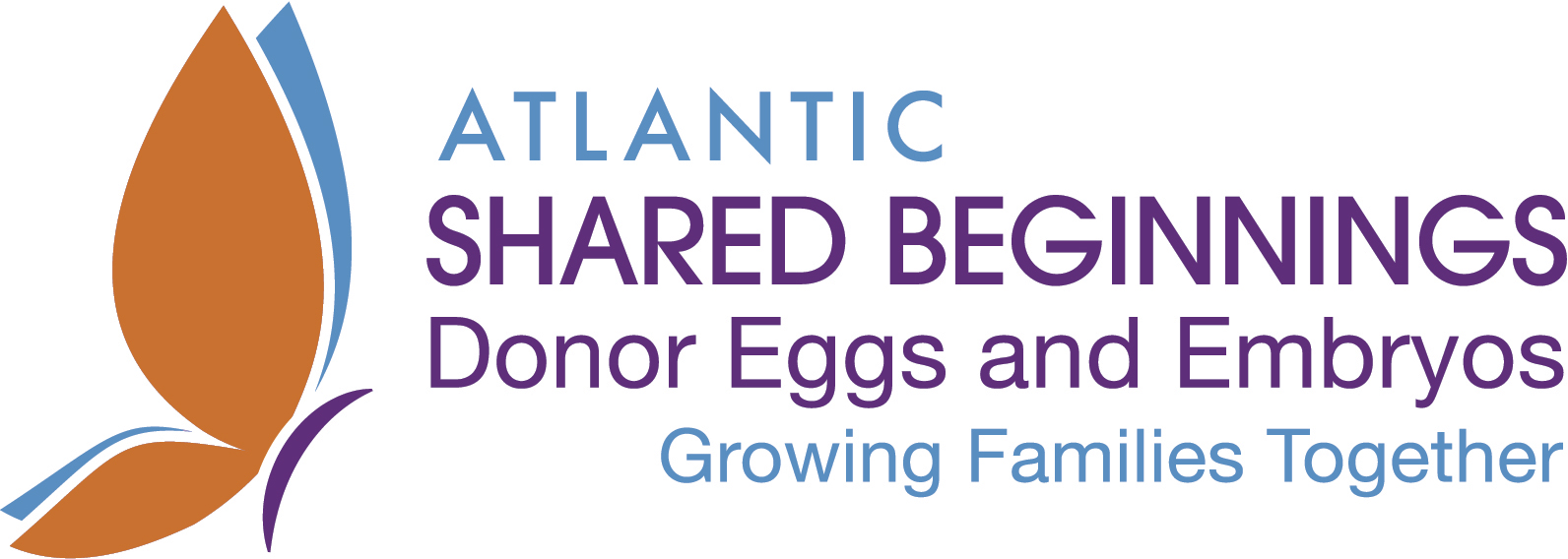– Program Director, Atlantic Shared Beginnings
There are many pathways to starting or growing your family, and donor eggs are becoming more widely utilized as an effective route to parenthood. In many cases, donor eggs give women a chance at pregnancy when there would be no other option.
Reasons for using Donor Eggs:
- Ovarian failure
- Low/failed ovarian stimulation response
- Missing or removed ovaries
- Poor egg quality
- Diminished ovarian reserve (DOR)
- Damage due to chemotherapy or radiation therapy
- Medical disorders
- Advanced maternal age (AMA)
- Presence of an inheritable disease
- Multiple failed IVF cycles
- Premature menopause
- Personal reasons
When it comes to personal reasons, one of the biggest is a patient’s belief that the gene pool isn’t the best one to pass down to a child. Using donor eggs may allow couples to help their child avoid some of the difficulties they experienced.
The American Society of Reproductive Medicine (ASRM) has great information for patients who want more information about Egg Donation.
There is a wide selection of donor egg options to choose from globally:
- Donor egg banks
- Traditional donor egg cycles
- Shared donor egg cycles
- Guaranteed donor egg programs
- Donated embryos (commonly known as embryo adoption)
- Donor embryo programs
So where does one start? A simple internet search of “donor eggs” gives pages of options, and at the top of the page, you will see “Donor Egg Banks.”
What is a Donor Egg Bank?
A donor egg bank offers a large pool of available donor eggs that have already been frozen. Typically, an egg bank offers cohorts of eggs, which usually include six to eight mature, frozen donor eggs. Usually, an egg donor produces multiple cohorts with each donation cycle. The cost range for each cohort is $12,000 to $16,000. There are advantages as well as disadvantages to using an egg bank.
Advantages of using an egg bank:
- Egg banks usually offer a wide selection of donors
- Eggs are already frozen, so you aren’t risking a low response from your donor
- Egg banks will ship the eggs (at your expense) to your chosen clinic
- Most egg banks offer an embryo guarantee
Disadvantages of using an egg bank:
- Not all eggs survive the thawing process
- Frozen eggs may yield a lower blastocyst rate, lower implantation rates, and lower live birth rates due to damage from the freeze/thaw process.
- Eggs are often frozen at a variety of clinics and sold to the banks, resulting in a range of thaw and pregnancy successes.
- The price charged by the egg bank is for the eggs only. Recipients must pay for eggs to be shipped, thawed, fertilized, and cultured at their chosen clinic for an additional cost range of $8,000–$14,000.
- If, after a successful pregnancy, donor egg recipients wish to grow their family through another donation, more eggs may not be available from the same donor.
- Because donors often produce more than one cohort of eggs, more than one recipient may receive a cohort from the same donor.
What is a Traditional Egg Donor Cycle?
Traditional egg donor cycles are offered at most clinics with a donor program. In a traditional cycle, recipients choose their egg donor from a pool offered by the clinic or an egg donor agency that has a variety of donors waiting to be selected. When you are matched with an egg donor, she will start medications to stimulate her ovarian cycle to produce multiple eggs that are retrieved at maturation. After retrieval, donors are compensated a flat fee ranging from $4500–$12,000, depending on the clinic/agency agreement.
The resulting embryos are cultured in the laboratory. One or more of the cultured embryos is then transferred to the recipient, while the remaining embryos can be frozen for a later frozen embryo transfer. In a traditional egg donor cycle, recipients pay for donor fees and medications, the culture of the embryos, and their own medications and treatment for the embryo transfer. Typically, the cost range for a traditional egg donor cycle is $22,000–$38,000.
Advantages of traditional donor egg cycles:
- Recipients can sync cycles with the donor and transfer fresh embryos
- Recipients receive donor status reports several times during the stimulation process
- Generally, a healthy donor will have a good number of eggs retrieved, and all of them belong to the recipient
- Additional embryos can be frozen for future pregnancies
Disadvantages of traditional donor egg cycles:
- Traditional egg donor cycles are expensive
- All costs (medication, monitoring, insurance) associated with the donor cycle are the recipient’s responsibility
- Occasionally, the donor cycle will fail (the donor does not produce viable eggs, the eggs may not fertilize, or the embryos might not develop) and unless a recipient has paid for a guaranteed cycle, there is no recourse.
- Syncing the recipient’s cycle with the donor’s cycle can take time
- Occasionally, a chosen donor will change her mind or cancel the cycle for other reasons leaving recipients to start over with the selection of a new donor
- If multiple eggs are produced and fertilized, there may be an excess of frozen embryos that are not used.
What is a Shared Donor Egg Cycle?
A shared donor cycle is a cycle where the donor eggs and retrieval costs are shared between two or more recipients. After donor retrieval, the eggs are split equally between the two recipients and each recipient then pays for fertilization, culture of embryos, and transfer.
Advantages of shared donor egg cycles:
-
-
- Shared egg donor cycles are less expensive because the donor fees are split between two (or three) recipients
- Because you will have fewer eggs, you are able to avoid large numbers of embryos left in cryopreservation after your family is complete.
- In most cases, you can sync your cycle with the donor and transfer fresh embryos
-
Disadvantages of shared donor egg cycles:
- Occasionally, the donor cycle will fail and unless the recipient paid for a guaranteed cycle, there is no refund option
- If the donor produces a low number of eggs, there may not be enough to share between multiple recipients
- Trying to sync recipient and donor cycles takes time and may be further complicated if multiple recipients are syncing for fresh transfer
- Occasionally, a chosen donor will change her mind resulting in the need for a new donor and a new match with one to two other recipients
- Many times, shared cycle recipients do not have excess embryos to cryopreserve for future pregnancy
What is a Guaranteed Donor Egg Program?
Donor IVF social media chat rooms are abuzz about guaranteed donor egg programs. The word “guarantee” can mean many different things when talking about an IVF cycle. Perhaps the most important distinction is understanding that these programs are “shared risk,” meaning that the clinic takes on some of the risk by offering the guarantee based on guidelines favorable toward pregnancy outcomes. Recipients in a guaranteed program must meet program qualifications to participate. Additionally, medications and pre-cycle testing are the financial responsibility of recipients.
- Live Birth or Take-home Baby Guarantee: These programs guarantee that the donor cycle will result in a baby. This is the safest guarantee program to find, and it is also the most expensive. There are clinics that offer this type of plan, but be sure to read and understand all the costs, as fees can be cost-prohibitive for many. Additionally, these programs have the strictest qualifications so those who are accepted are often the ones who have the highest likelihood of success.
- Pregnancy Guarantee: These programs guarantee that a recipient will get pregnant. Some programs guarantee a visible heartbeat via ultrasound (around the 7th week of pregnancy) and others guarantee pregnancy to the second trimester. If the pregnancy is lost after the guaranteed date, a recipient’s money will not be refunded.
- Transfer Guarantee: These programs protect recipients from failed stimulation (no eggs), failed fertilization, or failed embryo development. The transfer guarantee promises an embryo to transfer.
- Blast Guarantee: Like the transfer guarantee, this program promises that the recipient will have a blastocyst (a day 5 or day 6 embryo) that can be transferred or frozen for future transfers. The blast guarantee is common for many Egg Bank Cohort purchases.
- Money Back Guarantee: These programs protect recipients’ investment. If the guarantee they agreed to is not met, the recipient receives their money back. These are among the strongest guarantees and are also the most expensive.
No matter how you choose to build your family, make sure to weigh the pros and cons of using donor eggs. Using donor eggs is one of the most advanced and effective forms of infertility treatment for women who have issues using their own eggs to conceive. Atlantic Shared Beginnings understands the donor egg process and is privileged to help people create and grow their families, affordably and with a guarantee. To get answers to more questions around using a donor egg or donor embryo, please schedule a free consultation with our director, Stephanie Bartlett.

